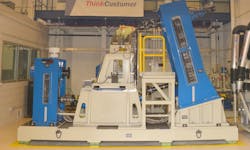A U.S. location of a European helicopter OEM was sending its gearboxes overseas for testing, often taking months for a single test to be completed. As a result, the OEM was spending too much time, money and labor packaging test articles, shipping them, and waiting for return shipment. It was reducing their production capacity and limiting growth.
The solution was to build a custom intermediate and tail rotor test system in the U.S. This new test bench would need to accommodate all five of the OEM’s helicopter gearboxes while also providing improved data quality, energy efficiency and a safe operator environment.
One challenge we faced in building this system for the OEM involved testing each article at appropriate levels of torque, speed and power. Since varying input ratios were required for each gearbox, we mounted a Planetary Torque Applier (PTA) within a gearbox to be driven by the main motor.
The purpose of the PTA is to create torque in the power loop by acting independently from the main drive motor. The PTA applies a phase displacement by operating in a slave mode relative to the main drive. Driven by a three-phase servo motor, the PTA and reducer gearbox achieve closed loop torque control and met the OEM’s test gearbox requirements.
The PTA motor also has the capability to create torque in both positive and negative directions increasing the flexibility of the system for future configurations.
Designing the test system with centralized unload and load stations, coupled with the fact that testing cycles last only a few hours, minimal manpower is required to operate the system. With just one flexible test machine to handle testing of all five of the OEM’s gearbox types, one fifth of the floor space and power is necessary to handle gearbox testing. This saves the OEM from numerous costs they would otherwise experience with five single gearbox test machines.
The test system’s controller can accommodate procedures for start-up, warm-up, manual test, and emergency shut down. Test program sets and special procedures can be easily programmed, providing automatic test control and improved safety for workers.
While traditional powertrain test braking systems can lose 100 percent of their power in wasted heat, this dynamic test system uses mechanical energy regeneration to capture up to 80 percent of its power for reuse in testing.
Test articles are prepped and disassembled on transportable fixtures outside the test machine, providing operators a more ergonomic working environment. Plus, instead of attaching cables and parts inside the machine for test, the fixtures allow operators to stand in an ergonomic position to place, dress and remove the test article.
Today, the OEM can test all five types of helicopter gearboxes in-house in a matter of hours, with minimal manpower and floor space.
Jason Stefanski is the director of Controls & Software Engineering for dynamic test systems at RedViking. RedViking has engineering centers in Michigan, North Carolina and Texas with customer support provided worldwide, and is a member of the Control System Integrators Association (CSIA). Visit RedViking’s profile on CSIA's Industrial Automation Exchange.
About the Author
Jason Stefanski
Director of Controls & Software Engineering for dynamic test systems at RedViking

Leaders relevant to this article:
